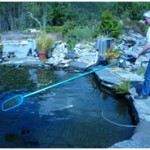The First Mention Of Filtration
No matter how we try to disguise the word, these are ‘boxes’ sited outside of the actual pond and contain an assortment of ‘gubbins’ inside these boxes that are there to ‘filter’ our pond water. ALL these boxes ‘work’ to a degree, right from placing a pair of disused ladies tights over the outlet of a pump. Much more on this later but now to the ONLY way possible of supplying these boxes with water when used in a fish pond application – if perfection is to be attained.
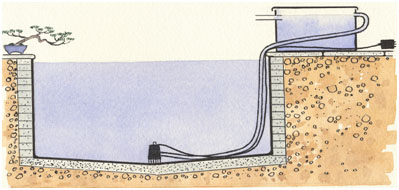 This is the ancient pump-fed system that is still in use today. There are many out there who still tell us all that their box can be ‘pump-fed’ – and who am I to argue? I know that I can also build a television set out of concrete blocks if I was silly enough. The truth is that the people who make these statements have no idea at all of fishpond filtration requirements and that is very sad.
This is the ancient pump-fed system that is still in use today. There are many out there who still tell us all that their box can be ‘pump-fed’ – and who am I to argue? I know that I can also build a television set out of concrete blocks if I was silly enough. The truth is that the people who make these statements have no idea at all of fishpond filtration requirements and that is very sad.
Above – ‘Pump-Fed’ system whereby the pump; electric supply cable and hose are all visible in the pond for us all to enjoy. It is a typical early ‘black box’ layout that should have been condemned by now.
Ah, the endless and idyllic summer days just fly by with a pump-fed system – pure relaxation!
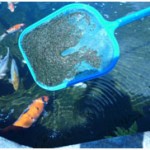 Net after net of very smelly yet ‘bracing and wonderful’ detritus keeps on coming – far too precious to allow it to be removed completely with a correctly sited bottom drain – and the endless maze of exposed pipelines all go towards making our pond as ‘aesthetically natural’ as is possible.
Net after net of very smelly yet ‘bracing and wonderful’ detritus keeps on coming – far too precious to allow it to be removed completely with a correctly sited bottom drain – and the endless maze of exposed pipelines all go towards making our pond as ‘aesthetically natural’ as is possible.
(We must obviously ignore the fact that our pump suction inlet will only pick up some 2” diameter of pond base debris unless, that is, we spend all day and every day wading in our pond and positioning it gently (without stirring up the clouds of detritus) in different areas of the pond base. )
If you are in any doubt as to where I stand on this matter, I would NEVER advocate this method to be used by any serious Koi enthusiast. As to those who say it can be done ‘properly’ – just form your own opinions as to whom you may choose to speak to in the future.
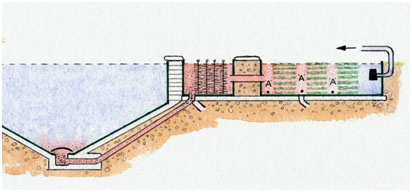 This next application is the ONLY possible way to go today if perfection is your goal and that is by a ‘gravity-fed’ application whereby the pond is linked to the filter box by a correctly sited bottom drain via a 4” (110mm) tube. This requires that water level in the pond is identical to that exact same level in the filter box and that pumps and pipe work can be concealed in the filter box and hidden from view. This produces a pond with only two things in sight – namely water and Koi.
This next application is the ONLY possible way to go today if perfection is your goal and that is by a ‘gravity-fed’ application whereby the pond is linked to the filter box by a correctly sited bottom drain via a 4” (110mm) tube. This requires that water level in the pond is identical to that exact same level in the filter box and that pumps and pipe work can be concealed in the filter box and hidden from view. This produces a pond with only two things in sight – namely water and Koi.
This is an intentionally over- exaggerated view of a gravity-fed application to show the pond, the drain & line and the box. The pump shown at the end of the box returns water to the pond constantly and the operation is painfully simple bearing in mind that it only has to be installed once. Yes, water levels need to be exact but that does not require the abilities of a rocket scientist. Theodolites or ‘dumpy levels’ can be hired cheaply to get this right the first time – I have used them on occasions and I cannot even hang wallpaper!
The actual operation is that when the system pump is switched off, the water levels in pond and box are identical. Switch on the pump (at the desired flow-rate – more later) and the pond water level will increase whilst the box level will decrease. Reduced level can easily be seen in the box as it has such a small surface area whilst the increase in pond level is almost undetectable. Now we have a difference of levels between pond and box, the laws of gravity come to our rescue here and the ‘head or weight’ of water in the pond compensates by reducing level in the only way possible unless we are faced with an overflow situation. In this instance, in order to ‘compensate’ water is pushed out of the only exit available, which is via the bottom drain and the 4” (110mm) tube linking the pond and box. This is not only means that the bottom drain passes visible contaminants into the box (faeces, leaves, uneaten food, dust, algae etc. – all heavier than water) it also passes other more dangerous ‘heavier than water’ dissolved toxins produced by the fish themselves. In short, proper bottom drains, correctly thought out and positioned, take everything we do not wish to have within our pond into the box exactly where we do wish it to go – and this vital action continues as long as the system pump is in operation.
Once again, this is just ‘simplicity’ and also painfully obvious – nothing ‘clever’ at all.
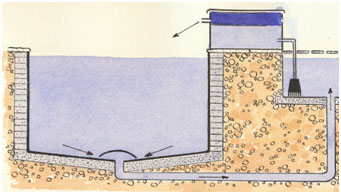 If you do wish, for whatever reason, to place your box ‘in the sky above your pond’ and return water by overflow back to the pond without resorting to the delightful pump-fed method covered earlier and still use a vital bottom drain, it can be done as seen here.
If you do wish, for whatever reason, to place your box ‘in the sky above your pond’ and return water by overflow back to the pond without resorting to the delightful pump-fed method covered earlier and still use a vital bottom drain, it can be done as seen here.
By building a small empty box next to the pond that need only be large enough to position a submersible pump then the bottom drain can be incorporated as shown.
However, this is still only a compromise, the pump box needs a drain to waste – yet this is light years ahead of the standard ‘pump-fed’ horrors.
On closing this section, there are other groundbreaking items available today to waste our money on if required. These go under a collective term of ‘Retro-Drains’ thought up by another inventive lunatic who has decided to make a killing in the fish pond industry. Alas, he too has not the faintest idea of what is required. Perhaps one day, he will make a computer-controlled version as seen in swimming pools where his wondrous design will glide over all base areas and wall areas of the pond and drag with it miles of pipe lines and power cables.
Being an old-fashioned individual I wonder to myself – why not just incorporate a proper bottom drain?

